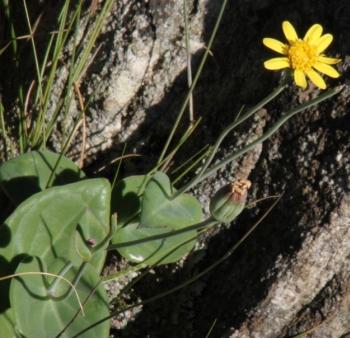Othonna perfoliata
Othonna perfoliata (L.f.) Jacq.
Family: Asteraceae
Common names: trailing othonna (Eng.); bobbejaankoolklimop (Afr.)
Introduction
An Othonna with striking yellow flowers, found lurking among tall vegetation, to brighten your garden in the cold winter days.

Description
Description
Othonna perfoliata is a tuberous perennial, producing slender, often scandent, annual stems arising from a woolly crown, up to 700 mm tall. The annual stems bear leathery, lance-shaped to rounded leaves, that are lobed at the base and clasping the stem. Flowerheads are solitary on long peduncles, radiate, 10–30 mm in diameter; involucral bracts 8 or 9. Fruits with stiff, short hairs on the ribs and a pappus of barbellate bristles; bristles 4–8 mm long, white.

Flowering time is from autumn to winter (May to August).
Conservation Status
Status
Othonna perfoliata is currently listed as Least Concern (LC) in the Red List of South African plants (Von Staden 2011).
Distribution and habitat
Distribution description
The species is relatively widely distributed in the extreme southwestern part of the Western Cape, from southern Namaqualand and the Bokkeveld Escarpment, along the west coast, inland to near Matjiesfontein. It occurs on sandstone flats and slopes, at altitudes below 1 000 m (Rowley 1994; Manning 2007; Manning & Goldblatt 2012).

Derivation of name and historical aspects
History
Othonna L. is a large and highly polymorphic genus of about 120, tuberous herbs or shrubby perennials, with a marked centre of diversity in southern Africa, mostly in the Western Cape and Namaqualand, but is also represented by a few species in the Eastern Cape, KwaZulu-Natal and southern Namibia (Nordenstam 2012). The genus is recognized by the presence of undivided (or minutely bifid) styles in disc florets (Nordenstam 2012). The epithet perfoliata refers to the stem-clasping leaves.
The species is vegetatively similar to Othonna undulosa, a species with disciform capitula (flowerheads) and acccrescent pappus, elongating up to 20 mm long. Because of this remarkable vegetative similarity, some authors e.g. Rowley (1994) had in the past treated these species as a single, variable species.
This species had until Manning and Goldblatt (2010), been known under 2 separate names, Othonna filicaulis and O. amplexifolia.

Ecology
Ecology
Fruits in Othonna perfoliata are very light and have a tuft of barbellate hairs (the pappus) on the top, which aids wind dispersal (Craib 1997). The species is semi-deciduous in summer, producing leaves in autumn and flowers in winter. O. perfoliata tends to twine its stem on nearby tall vegetation, probably to reach sunlight. The sweet scent of the flowers suggests that it may be beetle pollinated (Rowley 1994).
Uses
Use
None recorded. However, it has horticultural potential.
Growing Othonna perfoliata
Grow
Cultivation requirements are not yet known, but cultivation techniques suggested for these other species in the genus, O. euphorbioides, O. herrei and O. retrofracta, are likely to apply.
References
- Craib, C. 1997. Othonna euphorbioides, O. herrei and O. lepidocaulis: Their natural history and propagation. British Cactus and Succulent Society 15 (1), 41–47.
- Manning, J. 2007. Field guide to Fynbos. Struik Publishers, Cape Town.
- Manning, J.C. & Goldblatt, P. 2010. New synonyms and a new name in Asteraceae: Senecioneae from the southern African winter rainfall region. Bothalia 40 (1): 37–46.
- Manning, J. & Goldblatt, P. 2012. Plants of the Greater Cape Floristic Region 1: the Core Cape Flora. Strelitzia 29. South African National Biodiversity Institute, Pretoria.
- Nordenstam, B. 2012. Crassothonna B. Nord., a new African genus of succulent Compositae-Senecionae. Compositae Newsletter 20, 70–77.
- Rowley, G.D. 1994. Succulent compositae. A grower’s guide to the succulent species of Senecio & Othonna. Strawberry Press, California.
- Von Staden, L. 2011. Othonna perfoliata (L.f.) Jacq. National Assessment: Red List of South African plants version 2017.1. Accessed on 2018/02/21.
Credits
Luvo Magoswana
Compton Herbarium
April 2018
Plant Attributes:
Plant Type: Shrub, Succulent
SA Distribution: Northern Cape, Western Cape
Soil type: Sandy
Flowering season: Autumn, Winter
PH: Acid, Neutral
Flower colour: Yellow
Aspect: Full Sun, Afternoon Sun (Semi Shade)
Gardening skill: Easy
Special Features:
Horticultural zones








Rate this article
Article well written and informative
Rate this plant
Is this an interesting plant?
Login to add your Comment
Back to topNot registered yet? Click here to register.